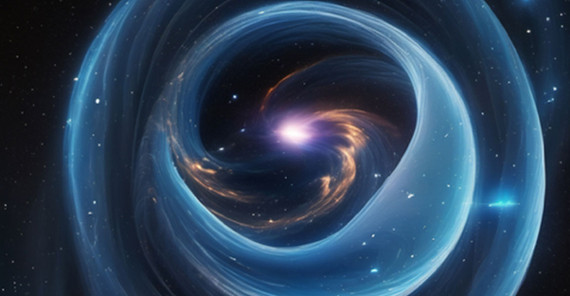A new study has simulated the gravitational waves produced by a collapsing warp drive, offering a potential new way to search for advanced spacefaring civilizations. The research, conducted by an international team of physicists, explores the theoretical consequences of a warp drive malfunction using sophisticated numerical simulations.
Warp Drives: From Science Fiction to Theoretical Physics
Warp drives, long a staple of science fiction, are hypothetical propulsion systems that could theoretically allow spacecraft to travel faster than light. While the concept remains firmly in the realm of speculation, it has a well-defined description within Einstein’s theory of General Relativity.
Dr. Katy Clough of Queen Mary University of London, the study’s lead author, explains: “Even though warp drives are purely theoretical, they have a well-defined description in Einstein’s theory of General Relativity, and so numerical simulations allow us to explore the impact they might have on spacetime in the form of gravitational waves.”
The idea of a warp drive, first proposed by physicist Miguel Alcubierre in 1994, involves creating a bubble of spacetime around a ship that contracts in front and expands behind, effectively moving the ship faster than light relative to distant objects. However, significant obstacles remain, including the need for exotic matter with negative energy density to create the warp bubble.
Simulating the Collapse: A New Signal in the Cosmos
The researchers simulated what would happen if a warp drive were to fail catastrophically. Their results reveal that such an event would produce a distinct burst of gravitational waves – ripples in the fabric of spacetime that could potentially be detected by future instruments.
Unlike the “chirp” signals produced by merging black holes or neutron stars, which current detectors like LIGO and Virgo are designed to observe, the gravitational waves from a collapsing warp drive would be a short, high-frequency burst. While existing detectors aren’t sensitive to these signals, the technology to build higher-frequency instruments capable of detecting them already exists.
This raises an intriguing possibility: even if we can’t build warp drives ourselves, we might be able to detect evidence of their use by more advanced civilizations. It’s a novel approach to the search for extraterrestrial intelligence, focusing on the potential technological signatures of faster-than-light travel.
Prof. Tim Dietrich from the University of Potsdam highlights another significant aspect of the study: “For me, the most important aspect of the study is the novelty of accurately modelling the dynamics of negative energy spacetimes, and the possibility of extending the techniques to physical situations that can help us better understand the evolution and origin of our universe, or the processes at the centre of black holes.”
Why it matters: This research opens up new avenues for exploring exotic spacetimes and pushing the boundaries of our understanding of general relativity. It also provides a potential new method for detecting advanced extraterrestrial civilizations, complementing traditional SETI approaches.
While practical warp drive technology remains a distant dream, this study demonstrates how theoretical physics can lead to unexpected insights and new ways of probing the universe. The team plans to continue their research, investigating how the gravitational wave signal might change with different warp drive models.
If our reporting has informed or inspired you, please consider making a donation. Every contribution, no matter the size, empowers us to continue delivering accurate, engaging, and trustworthy science and medical news. Independent journalism requires time, effort, and resources—your support ensures we can keep uncovering the stories that matter most to you.
Join us in making knowledge accessible and impactful. Thank you for standing with us!

